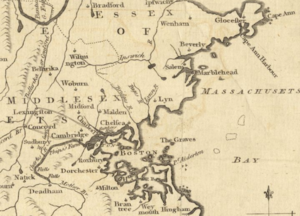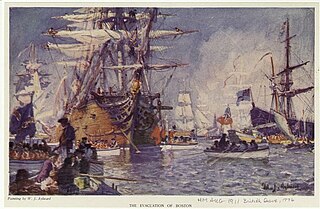
The Siege of Boston was the opening phase of the American Revolutionary War. In the siege, American patriot militia led by newly-installed Continental Army commander George Washington prevented the British Army, which was garrisoned in Boston, from moving by land. Both sides faced resource, supply, and personnel challenges during the siege. British resupply and reinforcement was limited to sea access, which was impeded by American vessels. The British ultimately abandoned Boston after eleven months, moving their troops and equipment north, to Nova Scotia.

The capture of Fort Ticonderoga occurred during the American Revolutionary War on May 10, 1775, when a small force of Green Mountain Boys led by Ethan Allen and Colonel Benedict Arnold surprised and captured the fort's small British garrison. The cannons and other armaments at Fort Ticonderoga were later transported to Boston by Colonel Henry Knox in the noble train of artillery and used to fortify Dorchester Heights and break the standoff at the siege of Boston.

The American Revolutionary War saw a series of battles involving naval forces of the British Royal Navy and the Continental Navy from 1775, and of the French Navy from 1778 onwards. Although the British enjoyed more numerical victories, these battles culminated in the surrender of the British Army force of Lieutenant-General Earl Charles Cornwallis, an event that led directly to the beginning of serious peace negotiations and the eventual end of the war. From the start of the hostilities, the British North American station under Vice-Admiral Samuel Graves blockaded the major colonial ports and carried raids against patriot communities. Colonial forces could do little to stop these developments due to British naval supremacy. In 1777, colonial privateers made raids into British waters capturing merchant ships, which they took into French and Spanish ports, although both were officially neutral. Seeking to challenge Britain, France signed two treaties with America in February 1778, but stopped short of declaring war on Britain. The risk of a French invasion forced the British to concentrate its forces in the English Channel, leaving its forces in North America vulnerable to attacks.
The first USS Franklin was a schooner in the Continental Navy during the American Revolutionary War. She was named for Benjamin Franklin.
The first USS Hancock was an armed schooner under the Continental Army during the American Revolutionary War. She was named for patriot and presiding officer of the Continental Congress, John Hancock. Congress returned her to her owner in 1777 after deeming the vessel to be unsuitable for the new Continental Navy.
The first USS Lee was a schooner under the Continental Army during the American Revolutionary War. She was named for General Charles Lee.

The Boston campaign was the opening campaign of the American Revolutionary War, taking place primarily in the Province of Massachusetts Bay. The campaign began with the Battles of Lexington and Concord on April 19, 1775, in which the local colonial militias interdicted a British government attempt to seize military stores and leaders in Concord, Massachusetts. The entire British expedition suffered significant casualties during a running battle back to Charlestown against an ever-growing number of militia.

The schooner Hannah was the first armed American naval vessel of the American Revolution, authorized by the Continental Congress and operated by the Continental Army, and is considered by some the first vessel of the United States Navy. She was a fishing schooner owned by John Glover of Marblehead, Massachusetts and was named for his daughter, Hannah Glover. The crew was drawn largely from the town of Marblehead, with much of the ship's ammunition being stored in Glover's warehouse now located at Glover's Square in Marblehead before being relocated to Beverly, Massachusetts.

The Battle of Chelsea Creek was the second military engagement of the Boston campaign of the American Revolutionary War. It is also known as the Battle of Noddle's Island, Battle of Hog Island and the Battle of the Chelsea Estuary. This battle was fought on May 27 and 28, 1775, on Chelsea Creek and on salt marshes, mudflats, and islands of Boston Harbor, northeast of the Boston peninsula. Most of these areas have since been united with the mainland by land reclamation and are now part of East Boston, Chelsea, Winthrop, and Revere.
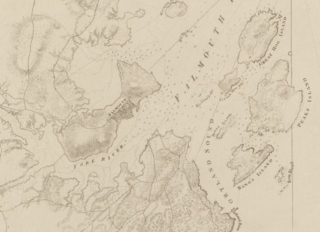
The Burning of Falmouth was an attack by a fleet of Royal Navy vessels on the town of Falmouth, Massachusetts. The fleet was commanded by Captain Henry Mowat. The attack began with a naval bombardment which included incendiary shot, followed by a landing party meant to complete the town's destruction. The attack was the only major event in what was supposed to be a campaign of retaliation against ports that supported Patriot activities in the early stages of the American Revolutionary War.
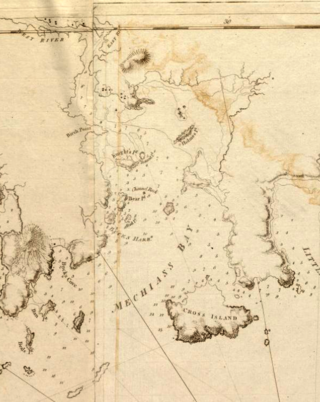
The Battle of Machias was an early naval engagement of the American Revolutionary War, also known as the Battle of the Margaretta, fought around the port of Machias, Maine.

American colonial marines were various naval infantry units which served during the Revolutionary War on the Patriot side. After the conflict broke out in 1775, nine of the rebelling Thirteen Colonies established state navies to carry out naval operations. Accordingly, several marine units were raised to serve as an infantry component aboard the ships of these navies. The marines, along with the navies they served in, were intended initially as a stopgap measure to provide the Patriots with naval capabilities before the Continental Navy reached a significant level of strength. After its establishment, state navies, and the marines serving in them, participated in several operations alongside the Continental Navy and its marines.
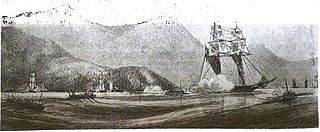
The action of 1 January 1800 was a naval battle of the Quasi-War that took place off the coast of present-day Haiti, near the island of Gonâve in the Bight of Léogâne. The battle was fought between an American convoy of four merchant vessels escorted by the United States naval schooner USS Experiment, and a squadron of fourteen armed barges manned by Haitian sailors.
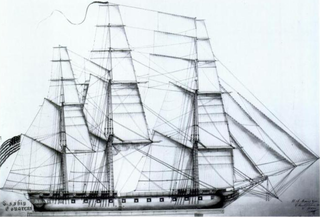
The West Indies Squadron, or the West Indies Station, was a United States Navy squadron that operated in the West Indies in the early nineteenth century. It was formed due to the need to suppress piracy in the Caribbean Sea, the Antilles and the Gulf of Mexico region of the Atlantic Ocean. This unit later engaged in the Second Seminole War until being combined with the Home Squadron in 1842. From 1822 to 1826 the squadron was based out of Saint Thomas Island until the Pensacola Naval Yard was constructed.
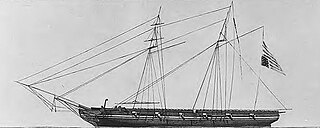
The West Indies Anti-Piracy Operations were a series of military operations and engagements undertaken by the United States Navy against pirates in and around the Antilles. Between 1814 and 1825, the American West Indies Squadron hunted pirates on both sea and land, primarily around Cuba and Puerto Rico. After the capture of Roberto Cofresi in 1825, acts of piracy became rare, and the operation was considered a success, although limited occurrences went on until slightly after the start of the 20th century.

HMS Surprise was a 28-gun Enterprise-class sixth-rate frigate of the Royal Navy, which served throughout the American Revolutionary War and was broken up in 1783.
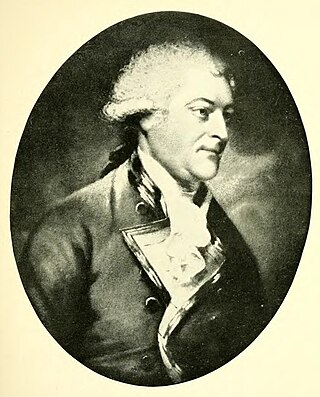
Admiral Robert Linzee was an officer of the Royal Navy who served during the American War of Independence, and the French Revolutionary and Napoleonic Wars.
HMS Canceaux was a sloop active in both the hydrographic exploration of the Atlantic Canada and New England coastline and in the American Revolutionary War. She played an integral role in the battle for control of Maine, in particular at the Burning of Falmouth. She began her life as a merchant vessel and would eventually be transformed to a military vessel for the Royal Navy, equipped to command the razing of major settlements. After leaving the Saint Lawrence River estuary in 1771, Canceaux actively shaped the maritime history of the American Revolution.
Henry Mowat (1734–1798) was an officer of the Royal Navy commanding ships in northern New England during the American Revolutionary War. He was the son of Captain Patrick Mowat of the post ship HMS Dolphin. He was born in Scotland and went to sea at the age of 18.

The first USS Mosquito was believed to have been purchased at Philadelphia late in 1775 for the new Continental Navy. She patrolled the Delaware River until destroyed during the British capture of Philadelphia led by the Howe brothers and completed by them in October 1777. The Dictionary of American Naval Fighting Ships (DANFS) has identified this ship as a sloop, yet records from the period which are believed to refer to the ship have consistently identified her as being a schooner. These records also provide a bit more detail of her fate, indicating she was burned after capture in July 1777 during Royal Navy operations along the Delaware River.
